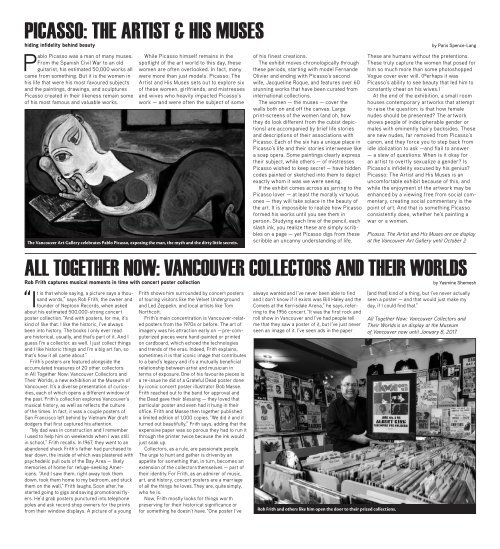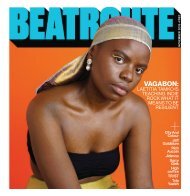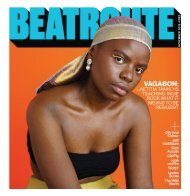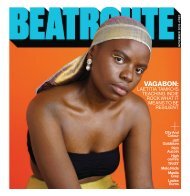BeatRoute Magazine B.C. print e-edition - July 2016
BeatRoute Magazine is a monthly arts and entertainment paper based in Western Canada with a predominant focus on music – local, independent or otherwise.
BeatRoute Magazine is a monthly arts and entertainment paper based in Western Canada with a predominant focus on music – local, independent or otherwise.
Create successful ePaper yourself
Turn your PDF publications into a flip-book with our unique Google optimized e-Paper software.
PICASSO: THE ARTIST & HIS MUSES<br />
hiding infidelity behind beauty<br />
Pablo Picasso was a man of many muses.<br />
From the Spanish Civil War to an old<br />
guitarist, his estimated 50,000 works all<br />
came from something. But it is the women in<br />
his life that were his most favoured subjects<br />
and the paintings, drawings, and sculptures<br />
Picasso created in their likeness remain some<br />
of his most famous and valuable works.<br />
While Picasso himself remains in the<br />
spotlight of the art world to this day, these<br />
women are often overlooked. In fact, many<br />
were more than just models. Picasso: The<br />
Artist and His Muses sets out to explore six<br />
of these women, girlfriends, and mistresses<br />
and wives who heavily impacted Picasso’s<br />
work — and were often the subject of some<br />
The Vancouver Art Gallery celebrates Pablo Picasso, exposing the man, the myth and the dirty little secrets.<br />
of his finest creations.<br />
The exhibit moves chronologically through<br />
these periods, starting with model Fernande<br />
Olivier and ending with Picasso’s second<br />
wife, Jacqueline Roque, and features over 60<br />
stunning works that have been curated from<br />
international collections.<br />
The women — the muses — cover the<br />
walls both on and off the canvas. Large<br />
<strong>print</strong>-screens of the women (and oh, how<br />
they do look different from the cubist depictions)<br />
are accompanied by brief life stories<br />
and descriptions of their associations with<br />
Picasso. Each of the six has a unique place in<br />
Picasso’s life and their stories interweave like<br />
a soap opera. Some paintings clearly express<br />
their subject, while others — of mistresses<br />
Picasso wished to keep secret — have hidden<br />
codes painted or sketched into them to depict<br />
exactly whom it was we were seeing.<br />
If the exhibit comes across as jarring to the<br />
Picasso lover — at least the morally virtuous<br />
ones — they will take solace in the beauty of<br />
the art. It is impossible to realize how Picasso<br />
formed his works until you see them in<br />
person. Studying each line of the pencil, each<br />
slash ink, you realize these are simply scribbles<br />
on a page — yet Picasso digs from these<br />
scribble an uncanny understanding of life.<br />
by Paris Spence-Lang<br />
These are humans without the pretentions.<br />
These truly capture the women that posed for<br />
him so much more than some photoshopped<br />
Vogue cover ever will. (Perhaps it was<br />
Picasso’s ability to see beauty that led him to<br />
constantly cheat on his wives.)<br />
At the end of the exhibition, a small room<br />
houses contemporary artworks that attempt<br />
to raise the question: is that how female<br />
nudes should be presented? The artwork<br />
shows people of indecipherable gender or<br />
males with eminently hairy backsides. These<br />
are new nudes, far removed from Picasso’s<br />
canon, and they force you to step back from<br />
idle idolization to ask —and flail to answer<br />
— a slew of questions: When is it okay for<br />
an artist to overtly sexualize a gender? Is<br />
Picasso’s infidelity excused by his genius?<br />
Picasso: The Artist and His Muses is an<br />
uncomfortable exhibit because of this, and<br />
while the enjoyment of the artwork may be<br />
enhanced by a viewing free from social commentary,<br />
creating social commentary is the<br />
point of art. And that is something Picasso<br />
consistently does, whether he’s painting a<br />
war or a woman.<br />
Picasso: The Artist and His Muses are on display<br />
at the Vancouver Art Gallery until October 2<br />
ALL TOGETHER NOW: VANCOUVER COLLECTORS AND THEIR WORLDS<br />
Rob Frith captures musical moments in time with concert poster collection<br />
by Yasmine Shemesh<br />
that whole saying, a picture says a thousand<br />
words,” says Rob Frith, the owner and<br />
“It is<br />
founder of Neptoon Records, when asked<br />
about his estimated 500,000-strong concert<br />
poster collection. “And with posters, for me, it’s<br />
kind of like that. I like the historic, I’ve always<br />
been into history. The books I only ever read<br />
are historical, usually, and that’s part of it. And I<br />
guess I’m a collector, as well. I just collect things<br />
and I like historic things and I’m a big art fan, so<br />
that’s how it all came about.”<br />
Frith’s posters are featured alongside the<br />
accumulated treasures of 20 other collectors<br />
in All Together Now: Vancouver Collectors and<br />
Their Worlds, a new exhibition at the Museum of<br />
Vancouver. It’s a diverse presentation of curiosities,<br />
each of which opens a different window of<br />
the past. Frith’s collection explores Vancouver’s<br />
musical history, as well as reflects the culture<br />
of the times. In fact, it was a couple posters of<br />
San Francisco left behind by Vietnam War draft<br />
dodgers that first captured his attention.<br />
“My dad was in construction and I remember<br />
I used to help him on weekends when I was still<br />
in school,” Frith recalls. In 1967, they went to an<br />
abandoned shack Frith’s father had purchased to<br />
tear down, the inside of which was plastered with<br />
psychedelic pull outs of the Bay Area — likely<br />
memories of home for refuge-seeking Americans.<br />
“And I saw them, right away took them<br />
down, took them home to my bedroom, and stuck<br />
them on the wall,” Frith laughs. Soon after, he<br />
started going to gigs and saving promotional flyers.<br />
He’d grab posters punctured into telephone<br />
poles and ask record shop owners for the <strong>print</strong>s<br />
from their window displays. A picture of a young<br />
Frith shows him surrounded by concert posters<br />
of touring visitors like the Velvet Underground<br />
and Led Zeppelin, and local artists like Tom<br />
Northcott.<br />
Frith’s main concentration is Vancouver-related<br />
posters from the 1970s or before. The art of<br />
imagery was his attraction early on — pre-computerized<br />
pieces were hand-painted or <strong>print</strong>ed<br />
on cardboard, which echoed the technologies<br />
and trends of the eras. Indeed, Frith explains,<br />
sometimes it is that iconic image that contributes<br />
to a band’s legacy and it’s a mutually beneficial<br />
relationship between artist and musician in<br />
terms of exposure. One of his favourite pieces is<br />
a re-issue he did of a Grateful Dead poster done<br />
by iconic concert poster illustrator Bob Masse.<br />
Frith reached out to the band for approval and<br />
the Dead gave their blessing — they loved that<br />
particular poster and even had it hung in their<br />
office. Frith and Masse then together published<br />
a limited <strong>edition</strong> of 1,000 copies. “We did it and it<br />
turned out beautifully,” Frith says, adding that the<br />
expensive paper was so porous they had to run it<br />
through the <strong>print</strong>er twice because the ink would<br />
just soak up.<br />
Collectors, as a rule, are passionate people.<br />
The urge to hunt and gather is driven by an<br />
appetite for something that, in turn, becomes an<br />
extension of the collectors themselves — part of<br />
their identity. For Frith, as an admirer of music,<br />
art, and history, concert posters are a marriage<br />
of all the things he loves. They are, quite simply,<br />
who he is.<br />
Now, Frith mostly looks for things worth<br />
preserving for their historical significance or<br />
for something he doesn’t have. “One poster I’ve<br />
always wanted and I’ve never been able to find<br />
and I don’t know if it exists was Bill Haley and the<br />
Comets at the Kerrisdale Arena,” he says, referring<br />
to the 1956 concert. “It was the first rock and<br />
roll show in Vancouver and I’ve had people tell<br />
me that they saw a poster of it, but I’ve just never<br />
seen an image of it. I’ve seen ads in the paper<br />
Rob Frith and others like him open the door to their prized collections.<br />
[and that] kind of a thing, but I’ve never actually<br />
seen a poster — and that would just make my<br />
day, if I could find that.”<br />
All Together Now: Vancouver Collectors and<br />
Their Worlds is on display at the Museum<br />
of Vancouver now until January 8, 2017<br />
<strong>July</strong> May <strong>2016</strong> 29


















